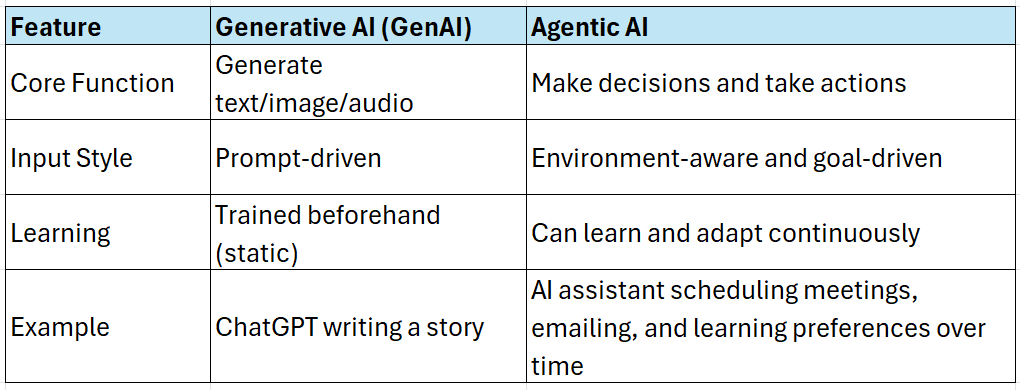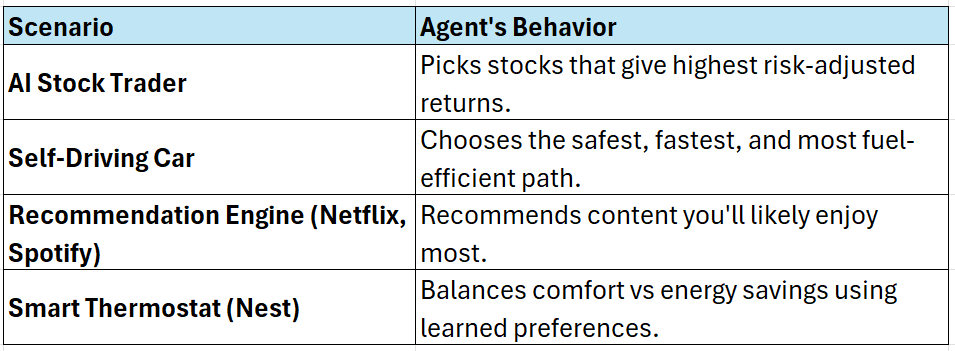From Chatbots to Autonomous Thinkers – A Journey into Agentic AI
Understanding How Intelligent Agents Sense, Plan, Act, and Learn in the Real World
Imagine an AI that not only chats with you but also plans tasks, makes decisions, takes actions, and learns from its mistakes. That’s the promise of Agentic AI – the next leap beyond ChatGPT-style responses. In this article, we’ll explore what Agentic AI is, how it works, and even see how to build a basic agent in Python!
What is Agentic AI?
Agentic AI refers to intelligent systems that behave like autonomous agents – meaning they perceive the environment, decide what to do, act, and learn from outcomes.
Key Characteristics of Agentic AI:
1. Autonomy
The agent acts independently, making decisions and taking actions without waiting for external commands.
Analogy: Think of the difference between a microwave (you operate it) and a self-cooking kitchen robot that notices you’re hungry and starts preparing a meal for you without being asked.
2. Goal-Driven Behavior
An agent doesn’t just generate outputs—it actively pursues goals. These goals are encoded in its logic or defined dynamically at runtime.
For example, an email-sorting agent that reorganizes your inbox based on your reading habits and priorities.
3. Continuous Learning
Agents learn from their environment and past decisions. This enables adaptability and improved performance over time.
GenAI vs Agentic AI
Reactive vs Deliberative Agents
Reactive Agents: Think of them like light sensors – they respond immediately to input without memory or planning.
Deliberative Agents: These are planners – they think before acting.
Example:
A Reactive Agent in a thermostat adjusts temperature based on current room temp.
A Deliberative Agent in a smart home considers your past preferences, outside weather, and electricity usage before setting the temperature.
Agent Architectures
There are different agent architectures based on how smart and adaptive the agent needs to be.
1. Simple Reflex Agents
How it works:
Acts only based on current input.
Follows fixed if-this-then-that rules.
Has no memory or understanding of the world.
2. Model-Based Reflex Agents
How it works:
Uses internal memory (model) to keep track of the world.
Can handle partially observable environments.
More flexible than simple reflex agents.
3. Goal-Based Agents
How it works:
Has a goal and chooses actions that lead to achieving it.
Involves search, planning, and decision-making.
Needs a model of the environment.
4. Utility-Based Agents
How it works:
Doesn’t just aim for the goal, but chooses actions that maximize performance or satisfaction.
Uses a utility function to score options and pick the best.
Great for environments with multiple competing goals or uncertainty.
When to Use What?
Single-Agent Workflows
Let’s break down what an agent actually does in real-time.
Standard Agent Loop:
Sense → Plan → Act → Learn
Example:
Sense: Read temperature.
Plan: If too hot, decide to turn AC on.
Act: Trigger the AC API.
Learn: Log effectiveness – was it cooled as expected?
Analogy: A human walking into a room (Sense), realizing it’s dark (Plan to turn on the light), doing so (Act), and next time remembering to check the switch position first (Learn).
A Simple Agent in Python
Let’s implement a toy Goal-Based Agent that plans lunch based on weather:
def sense_environment():
weather = input("What's the weather? (hot/cold): ")
return weather
def plan(weather):
if weather == 'hot':
return "Eat cold salad"
elif weather == 'cold':
return "Eat hot soup"
else:
return "Drink water"
def act(decision):
print(f"Action: {decision}")
# Agent Loop
def run_agent():
weather = sense_environment()
decision = plan(weather)
act(decision)
run_agent()Triggering Tools or APIs from an Agent
Agents can interact with real-world tools like:
import requests
def trigger_weather_api():
response = requests.get("https://api.weatherapi.com/v1/current.json",
params={"key": "your_api_key", "q": "Hyderabad"})
return response.json()["current"]["temp_c"]
def run_smart_agent():
temp = trigger_weather_api()
if temp > 30:
print("Turning on AC via smart home API")
else:
print("Opening windows for natural air")
run_smart_agent()
Key Takeaways
Agentic AI brings autonomy, action, and adaptability to the world of AI.
Understanding agent architectures helps you design the right type of intelligence for different problems.
Real-world agents are being built for finance, healthcare, smart homes, retail automation, logistics, and even education.
A single-agent system follows a loop of sensing, planning, acting, and learning—a structure that can scale with complexity.
With just Python and APIs, you can build foundational agent prototypes today!
Final Thoughts
Agentic AI is not just another chatbot. It's the foundation for smart assistants, self-driving systems, AI CEOs, and robotic helpers of tomorrow. Understanding the difference between reactive and goal-based agents, the architecture behind intelligent behavior, and implementing basic workflows will help you ride the AI wave ahead of the curve.
For more in-depth technical insights and articles, feel free to explore:
Girish Central
LinkTree: GirishHub – A single hub for all my content, resources, and online presence.
LinkedIn: Girish LinkedIn – Connect with me for professional insights, updates, and networking.
Ebasiq
Substack: ebasiq by Girish – In-depth articles on AI, Python, and technology trends.
Technical Blog: Ebasiq Blog – Dive into technical guides and coding tutorials.
GitHub Code Repository: Girish GitHub Repos – Access practical Python, AI/ML, Full Stack and coding examples.
YouTube Channel: Ebasiq YouTube Channel – Watch tutorials and tech videos to enhance your skills.
Instagram: Ebasiq Instagram – Follow for quick tips, updates, and engaging tech content.
GirishBlogBox
Substack: Girish BlogBlox – Thought-provoking articles and personal reflections.
Personal Blog: Girish - BlogBox – A mix of personal stories, experiences, and insights.
Ganitham Guru
Substack: Ganitham Guru – Explore the beauty of Vedic mathematics, Ancient Mathematics, Modern Mathematics and beyond.
Mathematics Blog: Ganitham Guru – Simplified mathematics concepts and tips for learners.









